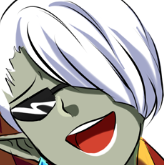Post by Desert on Dec 18, 2008 16:14:36 GMT -5
There are several key differences between whers and their draconic cousins.
They are smaller, usually five to ten meters different.
Their hides are tougher and leathery, and often duller or darker in color than a dragon's. They are quite repulsive to look at sometimes; more reptilian in appearance. Their wings are proportionally much smaller; they can fly, but only at night, when the air is cooler and more dense.
Their eyes are very sensitive to light. They see heat signatures, like a terran pit-viper, and bright sunlight hurts their eyes. They can go between like a dragon, but this skill is under-used and under-appreciated.
Whers take parts of their handler's name and add -sk to the end when they name themselves, instead of a dragon's -th ending. Some watch-whers, when they are the guardians of a major Hold, take the Hold's name -- Solsesk, for example. One can judge the strength of the wher's bond with its handler depending on how much of the handler's name was used -- for example, if the handler's name is Kindan, the wher is more tightly bonded if its name is Kindask rather than Kisk. Wher names comprising of more than one syllable are rarer.
They don't chew firestone and flame. A wher's defense against Thread is to go out at night and devour it, like fire-lizards. Also like fire-lizards, they can't articulate their thoughts into language. They can send emotions, sensory-input, and the abstract form of their thoughts to their handler, but not words.
They are not as intelligent as dragons, and more independent: a wher can survive without a handler bonded to them, and there have been cases where a wher actually picked a new handler to bond with who was not the handler it was hatched by. Many Hold watch-whers, in the past, have not been bonded to a handler. These are usually the ones who take the Hold's name instead of a human's name for themselves.
Whers have been known to maul humans at any stage of their life. If they are surprised, if something or someone under their protection is threatened, &c. They were bred with more animalistic, feral instincts than dragons. After all, they would need to be alert all night long in case Thread fell on their Hold, instead the tendency of dragons (picked up from their riders) to relax their guard if nothing happens for a long time.
Watch-whers were designed to accomplish tasks just as important as any dragon, though they are much less glorious than their more graceful counterparts.
The nocturnal, more independent whers are much better suited to fighting Thread at night than dragons; riders, being human, have imperfect night vision, and can't safely fight Thread when by all rights they should be asleep. Whers, who can see as well or better at night than humans can in the daytime, can devour Thread as it falls while their handlers and the rest of the Hold or Hall is dead asleep.
They organize themselves as well as any dragon wing, led by queen whers to meet Thread as it falls. They don't need humans to fight, going by instinct that it just as effective as any tactic when Thread is falling.

